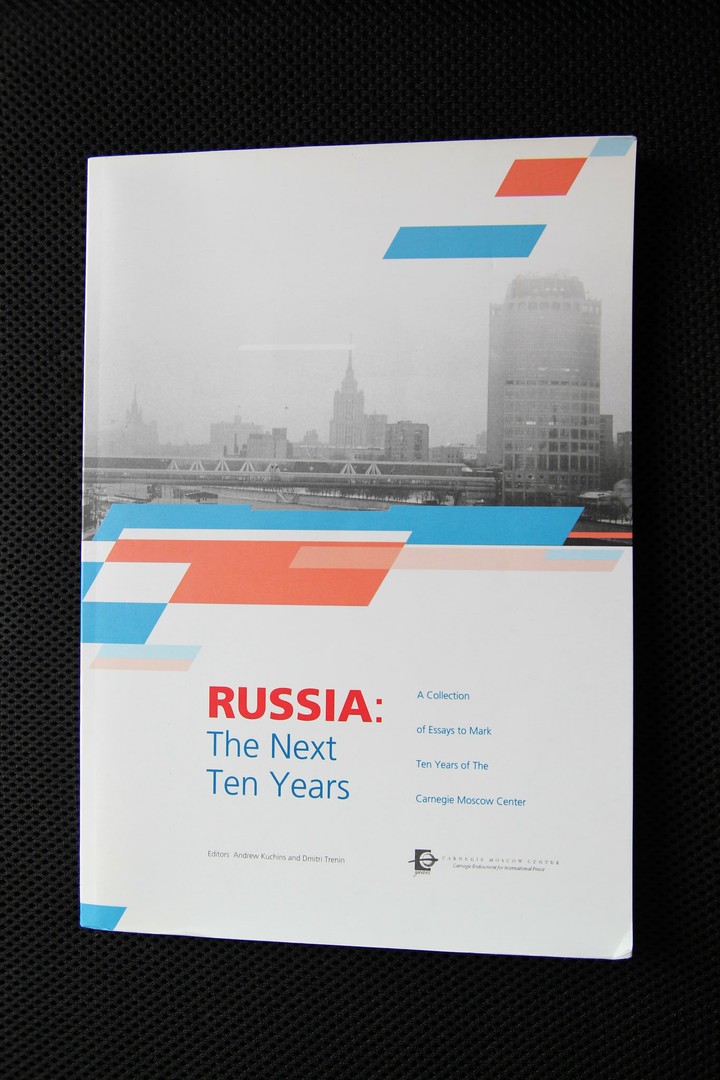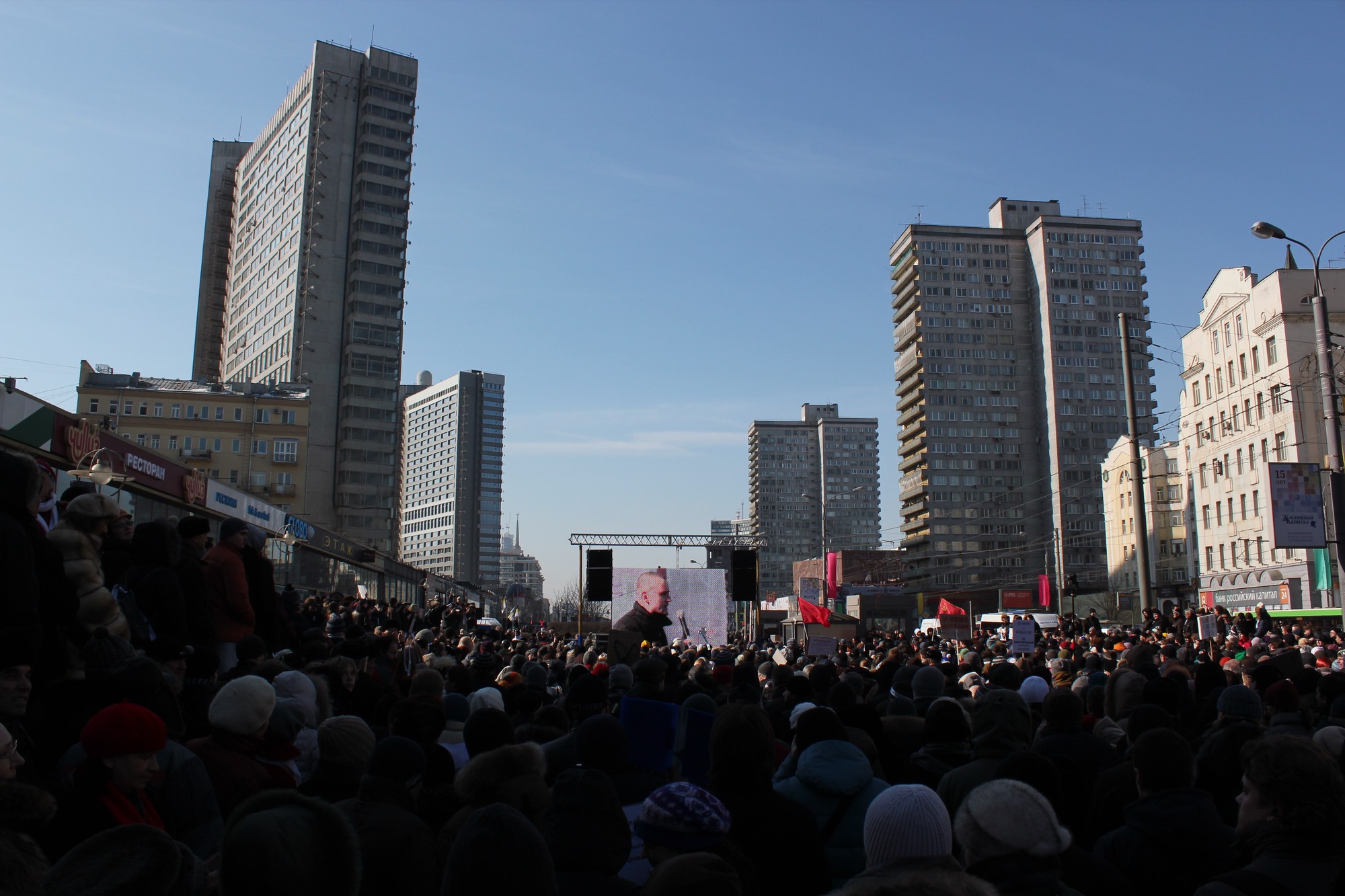Russia 2014 as imagined in 2004

In 2004, the Carnegie Moscow Center published a book titled “Russia: the next ten years” (Kuchins and Trenin, 2004). In the introduction, Kuchins makes clear that the aim of the publication is not “to predict” what would happen in the following ten years but rather “to elucidate the context for critical choices for Russian policymakers and the Russian people” (p. 10). However, many of the contributors tried to picture the Russia of 2014, often presenting both a more optimistic and a more pessimistic scenario.
As it turns out, they have depicted quite accurately some of the main developments of the last decade. When multiple possible outcomes were outlined in sectors such as the establishment of democracy, freedom of the media, and relations with the West, the most pessimistic option turned out to be the closest to the reality of 2014. The fact that one of the authors could refer matter-of-factly to Putin’s “pro-Western orientation” (p. 41) highlights just how much has changed in the last decade.
Domestic politics
In her contribution on domestic politics (“Russian power in 2014: an attempt at an intuitive forecast”), Lilia Shvetsova suggested that “irreconcilable contradictions will have accumulated by the 2008-2012 period, and society will begin looking for ways to pull itself out of stagnation” (p. 42). She proceeds suggesting that “there are two possible approaches to overcoming a hybrid reality in which incompatible trends oppose each other. The first way is to try once again to reinforce the status quo, this time by means of truly harsh administrative measures and force. The second way is to begin a gradual ‘decompression’ of the existing system of governance.”

Indeed, the months preceding the 2012 presidential elections witnessed mass demonstrations in Moscow demanding change. Harsh measures followed, including both targeted (Aleksei Navalny, Sergei Udaltsov) and indiscriminate arrests (Bolotnoe delo), thanks to the fact that, as Shevtsova predicted, “Putin’s new regime will be much more capable than the previous one of carrying out selective repressions” (p. 41).
Security and relations with the West
In his contribution, Micheal McFaul – later to become U.S. ambassador to Russia – pointed out what were the achievements of the decade before 2004: “Well into the 1990s, it remained unclear (1) if boundaries between new states would become permanent and peaceful, (2) if capitalism would ever take hold or (3) if democracy would ever be consolidated. Only a decade after this revolution began, two out of three of these transformations have been completed.”
“Russia’s borders are well defined today,” he added. “The Soviet empire is gone and will never be reconstituted. Belarus may join Russia again,1 but the likelihood of coercive subjugation of states and peoples adjacent to Russia’s borders is remote. […] But the current regime is unlikely to use force to redraw state boundaries” (p. 45).
McFaul turned out to be too optimistic, even if he later added that “some borders may change” (p. 48) and got closer to the realities of 2014 suggesting that “the erection of an autocratic regime in Russia could even disrupt the relative peace and stability among states in the region, since a dictator in the Kremlin would have to rely on nationalist ideology and the military to remain in power – a volatile combination” (p. 49).
The developments in Russia-West relations were anticipated quite accurately by Andrew Kuchins: “Growing Russian power that features more aggressive behavior on its periphery – behavior that some will call ‘imperialist’ – accompanied by decreasing democracy will be a recipe for a more contentious U.S.-Russian relationship. In the near term these trends will likely not keep us from cooperating to prevent the proliferation of weapons of mass destruction and to fight terrorism where and when it suits our mutual interests, or even to expand bilateral energy ties. But in the medium to longer term, these trends, if they are not reversed, will erode the sense of partnership and negate any possibility of a broader and deeper alliance between Russia and the United States and the West” (p. 94).
Russia, the EU, and the shared neighbourhood
Referring to developments in Russia’s relations with the CIS, Dmitri Trenin argued that “Moscow’s long-term objectives would be to form a single economic space for the leading CIS countries, common customs and currency unions, a collective security system and ultimately, a common foreign and defence policy” (p. 102). The establishment of the Eurasian Customs Union years later is clearly part of this project.
He also hinted at the tensions to come between Russia and the EU about their role in their shared neighbourhood. “The European Union already considers Ukraine, Moldova, Belarus and the nations of the southern Caucasus as its ‘near abroad’. Russia’s active policy in the CIS will lead to direct competition with the EU over the future orientation of these states. If Russia makes heavy-handed pressure and force part of its policy, Europe could again come to see Russia as a potential threat to its own security” (p. 102).
However, it is Putin’s own policies as expressed in a document presented at a Russia-EU summit in Helsinki in October 1999 (quoted by Hannes Adomeit in this volume), that most eerily anticipate what was going to happen. “Russia will counteract any attempt at hampering economic integration in the CIS. In particular, it opposes ‘special relations’ by the EU with individual countries of the CIS to the detriment of Russia’s interests” (p. 115). Adomeit concludes: “It is too early to say whether the drift of the Euroatlantic and the Eurasian continental plates away from each other will inexorably continue or whether it can be halted. Optimism is unwarranted, however. Putin’s course of managed democracy […] appears to be overwhelmingly popular.”
What about Crimea?
None of the authors mentions even passingly Crimea, war with Georgia, or the possibility of open warfare in Eastern Ukraine. Should we have known?2
In a recent op-ed in the New York Times, Timothy Garton Ash recollected a 1994 conference he attended, when a young Vladimir Putin intervened. Here’s an extended quote from the full transcript of the event published by the Körber Foundation of Hamburg (originally in German, my translation):
“Forget not that in the interests of security and peace in Europe, Russia has voluntarily given to former Soviet republics huge territories, including territories which historically have always belonged to Russia. I am not thinking only about Crimea or northern Kazakhstan, but also for example about the Kaliningrad area. The result is that now all of a sudden 25 million Russians live abroad, and Russia cannot allow – only in the interests of the security in Europe – that these people are arbitrarily abandoned to their fate. […] So long as the world community does not pay attention to the legitimate interests of the Russian state and the Russian people as a great nation, there will always be forces in this country which will arise and threaten the stability of Russia. I agree with previous speakers that a stable Russia is in the interests of all.”
Vladimir Putin in 1994 was already outspoken about the fact that the international community should acknowledge Russia’s legitimate interest in the fate of Russians living in its “near abroad”. In 1999, just months after becoming prime minister, he made clear that Russia strongly opposes “special relations” between the EU and CIS countries, and that it will actively counteract the establishment of such relations. The message was very clear.
However, we should not use hindsight to selectively pick elements of Putin’s rhetoric that are in line with current events, somehow implying that they just had to happen. Rather, this should serve as a reminder that, after all, Russia may not be as unpredictable as it is often claimed.
Thinking of 2024
Going through this collection of contributions written in 2004 on the Russia of 2014, one might be excused to agree with Julia Ioffe, who, referring to Russia, suggested in a recent piece that “all you really need to do to seem clairvoyant about the place is to be an utter pessimist."3
McFaul concluded his contribution suggesting that in 2014 we might well be speculating about the future of Russia’s regime, still likely to be “somewhere between dictatorship and democracy” (p. 49). But what about 2024? Given the amount of pessimism that currently dominates Russia watchers, applying the “Ioffe approach” to such an analysis is due to present an extremely gloomy picture of democracy in Russia, Russia-West relations and, more in general, of the security and cooperation environment in Europe in the next decade.
Policy makers, however, should be remembered that the script for the next ten years is not yet fully written. Anatol Lieven’s remarks in his contribution about “Russia and the U.S. in the southern Caucasus”, seem to be no less valid in 2014 than when they were written in 2004. They refer to the U.S, but apply also to Russia-EU relations in their shared neighbourhood. “Failures of both Russian and American strategy over the past decade should lead to greater modesty and wisdom in both Russia and the U.S. Neither country is going to be able to shape the region as it would wish. Neither has the resources or the will to establish an exclusive sphere of influence” (p. 129). Acknowledging this situation, both sides should opt for a more realistically moderate position, recognize their differences and try to engage in meaningful dialogue.4 Or, as suggested by Lieven, “they can continue the sterile competition for meaningless advantage which has characterized the past decade, and which benefited neither Russia, America, nor indeed the Caucasian peoples themselves” (p. 130). Nor, I would add in 2014, the posturing of Russia, EU and the U.S. about Ukraine will bring benefits either to Russia, the EU, the U.S., or residents of Ukraine themselves.
References
Shapovalova, Natalia, and Jarabik Balazs. 2009. “Crimea: Next Flashpoint in the European Neighbourhood?” Policy Brief 14. Madrid: Fride. http://www.fride.org/descarga/pb14_crimea-flash_point_eng_jul09.pdf.
Kuchins, Andrews, and Dmitri Trenin, eds. 2004. Russia: The Next Ten Years. Carnegie Moscow Center.
Kuzio, Taras. 2010. The Crimea: Europe’s Next Flashpoint? Jamestown Foundation Washington, DC. http://www.taraskuzio.net/media13_files/30.pdf.
-
Interestingly, also Dmitri Trenin in his contribution suggested that “after president Lukashenko leaves the political scene, Belarus might join the Russian Federation” (p. 102). ↩︎
-
In a way, it should be stressed, we did know. Maybe not in 2004, but as early as 2009 and 2010 we were told by various authors - (Shapovalova and Balazs, 2009). Crimea: Next Flashpoint in the European Neighbourhood?.) - Kuzio (2010). The Crimea: Europe’s Next Flashpoint - that Crimea’s sovereignty would be increasingly contested and that if no action was taken Crimea might well become the “next flashpoint in the European neighbourhood.” ↩︎
-
Of course, this is also a matter of perspectives. Many in Russia would claim that, quite to the contrary, the last decade proved to be successful in turning Russia into an economically stable country and an actor to be reckoned with at the international level; they might think that such achievements go beyond their most optimistic hopes of 2004. ↩︎
-
Indeed, Anatol Lieven made a very similar point in a March 2014 article published on Zócalo Public Square. ↩︎